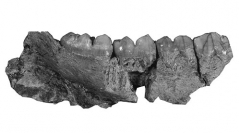

 Geodiversitas
26 (3) - Pages 509-534
Geodiversitas
26 (3) - Pages 509-534We describe here the topotypic series of Conohyus olujici n. sp. from the Croatian locality of Lučane. This sample was originally collected by local lignite miners in the 1930’s, who conveyed the sample to the parish’s Franciscan monk Dr. Josip Olujić. The Lučane Conohyus sample includes seven lower jaws and jaw fragments; no upper cheek teeth have yet been recovered. Our use of bivariate statistics, log10 ratio diagrams and a cladistic analysis all reveal that C. olujici n. sp. is the most primitive member of the Conohyus clade. The analyses reveal that: of the sample considered, only two species are referable to Parachleuastochoerus, P. sp. and P. crusafonti; Parachleuastochoerus is the sister-taxon to Conohyus; Conohyus is a clade, and C. olujici n. sp. is the sister-taxon of the C. steinheimensis-C. simorrensis and C. sindiensis clades. Conohyus olujici n. sp. would appear to have occurred at a time when the genus enjoyed a relatively continuous geographic range that extended from southern Europe to South Asia. Conohyus olujici n. sp. was evidently adapted to swamp forest habitats. Its paleodiet, as evidenced by its thick molar enamel and labiolingually expanded posterior premolars, likely included hard object frugivory.
Mammalia, Suidae, Tetraconodontinae, Conohyus, Lučane, Croatia, phylogeny, paleobiology